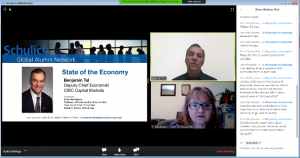 June 2020
June 2020
The time has come for virtual meetings, along with electronic voting and condo management software, to be embraced.
Interest in virtual meetings has grown in the wake of the covid pandemic. By virtual we refer to participants meeting without gathering at a specific location. Combined with electronic voting software, these technologies ensure annual general meetings, along with board and committee meetings, can continue when participants are physically separated.
Virtual meeting technology has evolved. In the 1980s, Kinkos was the place to go for copying, printing and technology services. The company established virtual meeting rooms in locations throughout Canada. While expensive to rent, it was more economical for parties to meet in physically separated meeting rooms than pay the cost of air travel and hotel. Today the same result can be accomplished without these meeting rooms. Individuals each equipped with internet access and an electronic device – desktop computer, laptop, tablet or smartphone – with microphone, camera, and software can have meetings at any time.
Some may claim the Condo Act does not allow for virtual meetings. Similar arguments have been made against the use of condo management software, e-mail, electronic voting and possibly fax machines. In fairness, the Condo Act does not state that any of these technologies are allowed. It also does not prohibit their use. The Condo Act identifies requirements for meetings, voting and other activities which can easily be better achieved through use of technology. While it is possible that some condominium corporations may have by-laws restricting use of some technologies, this too is unlikely. In the case of virtual meetings, it remains important to meet legal requirements such as attendance and quorum which can be achieved without attendees being physically present in the same room.
 Virtual meetings and webinars are affordable. Cost ranges from free to $30 per month without an annual commitment. Free services include Facetime, Skype and WhatsApp. As of May 2020 anyone with Gmail now has access to free and simplified virtual meetings by clicking a link below their e-mail folders. Paid services, some of which include limited free access, include Zoom, Webex and GoToMeeting/GoToWebinar which can be easier to use and include enhanced features. Some systems allow for recording of a meeting or webinar for posting on a website. Limitations of free access may be imposed on number of participants and meeting time. Zoom, for example, restricts free access to fewer than 100 participants and a 40-minute meeting limit.
Virtual meetings and webinars are affordable. Cost ranges from free to $30 per month without an annual commitment. Free services include Facetime, Skype and WhatsApp. As of May 2020 anyone with Gmail now has access to free and simplified virtual meetings by clicking a link below their e-mail folders. Paid services, some of which include limited free access, include Zoom, Webex and GoToMeeting/GoToWebinar which can be easier to use and include enhanced features. Some systems allow for recording of a meeting or webinar for posting on a website. Limitations of free access may be imposed on number of participants and meeting time. Zoom, for example, restricts free access to fewer than 100 participants and a 40-minute meeting limit.
What a virtual meeting looks like
Schulich School of Business hosted a webinar to 400+ attendees throughout the world using Zoom.


Images above two views presented to attendees. The left vieew displays the image of the speaker in a middle column. The right view includes images of the speaker and moderator. For an Annual General Meeting the leftmost image could be an agenda. The rightmost column is a chat feature allowing attendees to submit questions for a moderator to read aloud. Questions are submitted in the bottom right corner.
Views and microphone are controlled by the moderator.
 Meetings differ from webinars in that there are fewer attendees and all are visible to each other on the screen. Microphone may remain active for all attendees.
Meetings differ from webinars in that there are fewer attendees and all are visible to each other on the screen. Microphone may remain active for all attendees.
Choose the service
Deciding which service is best requires an estimate of participants or attendees, and involvement of those attending.
For two or three individuals a free service such as Facetime, Skype or WhatsApp may be adequate. For meetings with more attendees virtual meeting or webinar products such as Zoom, GoToMeeting or Webex can be easier and more effective.
Meeting Types
An Annual General Meeting generally involves one or few speakers with many inactive participants who may want to ask questions. For this a webinar can be more effective than a virtual meeting. Webinars allow for one person to communicate with many. The many can ask questions via an integrated chat box on the screen. The speaker reads and responds to questions. Attendee microphones are generally muted so nobody can interrupt the speaker or disrupt a meeting. A moderator may control the meeting by activating the microphone for whoever is to speak while addressing submitted questions.
Meetings differ in that individual attendees can interact as if they were seated together in a room at a table. This approach is more effective for board and committee meetings. The technology displays all attendees to each participant in a “Brady bunch format”. Participants interact as if they were seated at the same table. A moderator may choose to mute and unmute attendee microphones as necessary. Attendees can mute their own microphone until it comes time for them to speak thus avoiding the impact of background noise.
A toll-free dialing feature allows those without a computer to participate by phone.
Preparing for a Virtual Meeting
- Good quality high-speed internet access is necessary to avoid connection problems and poor audio or video transmission. Connection problems can occur if there is a weak or poor internet signal. Wireless access may be more inconsistent than wired connections.
- It may be necessary for participants to set up a free account with the service prior to participating in a meeting or webinar. Paid services are unlikely to require participant registration.
- Ensure your camera or video device, if used, is at eye level. Others participating in the meeting can then communicate with you at eye level.
- When using a camera or video device, avoid a location where lights or windows are situated behind you. This makes it difficult for others to see you.
- Keep your meeting space clean and void of unnecessary paper or other distractions others can see during a virtual meeting.
- Wear clothing you are comfortable being seen in. Don’t assume others can only see your face.







